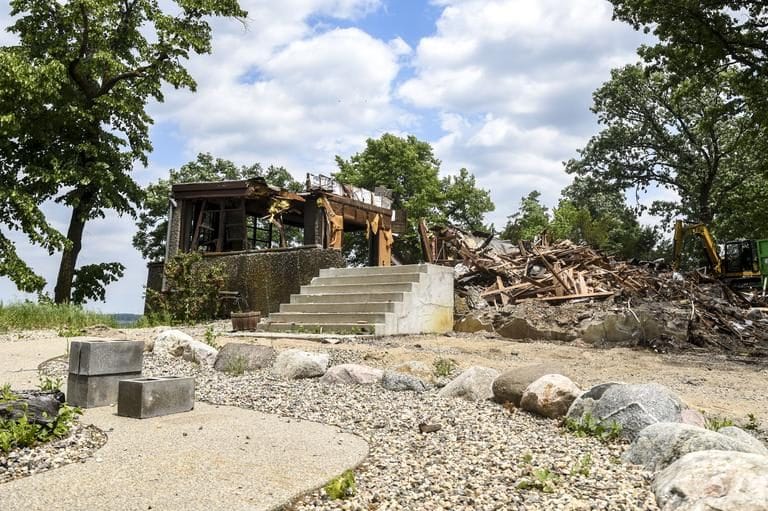With a crunch, a heave and a groan, the hydraulic arms of heavy machinery sank their jaws into the Spicer Castle Tuesday morning. And just like that, 125 years of history toppled in a heap.
Constructed in 1895 by Spicer founder John Spicer and long since operating as a bed and breakfast owned by the Latham family, the structure had fallen into disrepair after it had been put up for sale in 2018.
Although attempts were made by local entities to explore funding options for preserving the Castle, the costs necessary to restore the building ultimately proved impractically steep.
Spicer Mayor Denny Baker said he “hated to see it go,” but after several recent walk-throughs of the building, realized that the site would be far too expensive to restore and refurbish through the grants and tax breaks available to historic sites.
“When I saw what it would take, there’s no way we could come up with the dollars to maintain it, so it became quite certain to me that it would be destroyed,” he said.
Shortly after the Spicer Castle was listed for sale, Baker joined with a group of individuals from the city, county, historical society and Housing Redevelopment Authority, to determine what would be required to retain the landmark as an historical site.
Along with re-wiring and bringing the building up to code, additional challenges included attaining grants for private property. According to Historical Society Executive Director, Jill Wohnoutka, public historic sites, like the Sperry House, are eligible for the Minnesota Historical and Cultural Heritage Grants program (Legacy Grants). However, private property, such as the Spicer Castle, are not eligible for these grants. Instead, they are mainly limited to tax breaks.
We had great goals and good inspiration to do something with it, but it just became insurmountable with the costs involved.” Baker said.
However, the mayor is optimistic about the future plans for the site. The property was purchased in February by Diane Buzzeo and Debbie Longo, who plan to construct condominiums at a yet-to-be determined date.
A Spicer resident of over three decades, Buzzeo credits the Latham family with inspiring her to take up residence in the community.
“They were the first people I met in 1984 when I came to town,” she said. “Mary and Allen (Latham) were very good friends of ours, and I didn’t want to see (the Castle) go into the hands of outside developers who didn’t know the history of the lake. And since there was no possibility for anything besides demolition, I wanted it to be me that did it.
While the scope and layout of the condominiums have not yet been drafted. Buzzeo aims to retain the iconic history of the former landmark in her building plans.
“As we start through the development phase, our hope is to call it “Castles on Green,” and we’d like to work a castle theme into it.” She said “We’d like to have underground parking and there’s a whole lot of things we’d like to do, but we can’t really explore that until the building is down and we get a good handle on the land.”
Along with a castle theme, Buzzeo also hopes to keep the concrete steps that once led to the main entrance.
“I’m very excited about our vision for the future,” she said. “When John Spicer built the house, he built is because he had a vision of Spicer becoming a town, and that vision was realized. Without vision, there’s no future. So, we’re hoping we can take that property and legacy of the Spicer family into the next generation.”
Still, Buzzeo described the demolition as “emotional.”
As the site changes hands and a new age dawns, the razing of the house effectively signals the end of an era. Simply put, people aren’t as interested in resorts, inns and bed and breakfasts as they once were.
In the last decade alone, over 50% of the state’s resorts have closed, with recent estimates by the Association of Innkeepers International listing the average lifespan of these businesses at just five to seven years.
In a 2018 interview, shortly after the Castle was put up for sale, owners Mary and Allen Latham lamented the steady decline of inns as tourism destinations.
“When we opened in 1998, there were 17 resorts on Green Lake,” Mary said. “In the last one to two years, we’ve been the only property left on the lake; all others have been sold.”
Allen, who has since passed away, could only speculate as to why these businesses are suffering, but suspected a general shift in tourists’ interests as well as rising property taxes are to blame.
“Resorts are a thing of the past,” he said. “I can’t tell you exactly why, but that’s just the way it is.”
Lakes Area Review by Brett Blocker, Editor

